
Vsevolod I Yaroslavich was Grand Prince of Kiev from 1078 until his death in 1093.
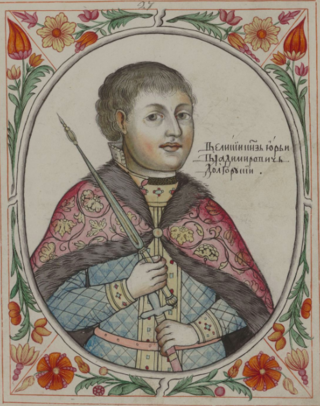
Yuri I Vladimirovich, commonly known as Yuri Dolgorukiy or the Long Arm, was a Monomakhovichi prince of Rostov and Suzdal, acquiring the name Suzdalia during his reign. Noted for successfully curbing the privileges of the landowning boyar class in Rostov-Suzdal and his ambitious building programme, Yuri transformed this principality into the independent power that would evolve into early modern Muscovy. Yuri Dolgorukiy was the progenitor of the Yurievichi, a branch of the Monomakhovichi.

Rogneda Rogvolodovna, also known as Ragnhild (Ragnheiðr), is a person mentioned in the Primary Chronicle as having been a princess of Polotsk, the daughter of Rogvolod (Ragnvald), who came from Scandinavia and established himself at Polotsk in the mid-10th century. Vladimir the Great is narrated as having killed her father and taking her as one of his wives.
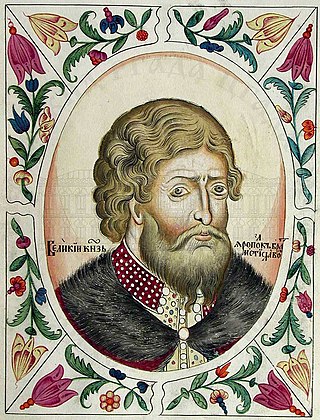
Yaropolk II Vladimirovich was Prince of Pereyaslavl (1114–1132) and Grand Prince of Kiev (1132–1139). He was a son of Vladimir II Monomakh and Gytha of Wessex. He fought in several campaigns against the Cumans, once in 1103 and again in 1116.

Mikhail Vsevolodovich, known as Michael or Mikhail of Chernigov, was Grand Prince of Kiev ; he was also Prince of Pereyaslavl (1206), Novgorod-Seversk (1219–1226), Chernigov, Novgorod, and Galicia (1235–1236).
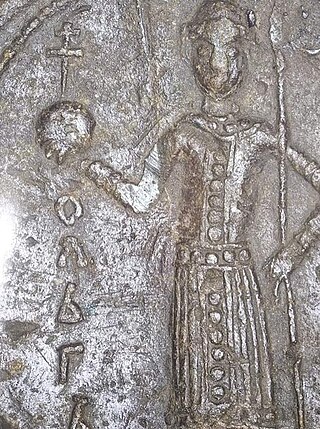
Oleg Svyatoslavich was a prince from Kievan Rus' whose equivocal adventures ignited political unrest in the country at the turn of the 11th and 12th centuries. He reigned as Prince of Chernigov from 1094 to 1097, and as Prince of Novgorod-Seversk from 1097 to 1115. He was the progenitor of the Olgovichi family.
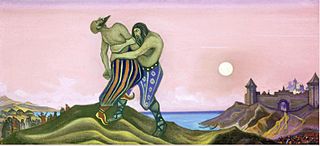
Mstislav Vladimirovich was the earliest attested prince of Tmutarakan and Chernigov in Kievan Rus'. He was a younger son of Vladimir the Great, the grand prince of Kiev. His father appointed him to rule Tmutarakan, an important fortress by the Strait of Kerch, in or after 988.

Boris Vyacheslavich was Prince of Chernigov for eight days in 1077. He was the son of Vyacheslav Yaroslavich, Prince of Smolensk. Following his father's death in 1057, the child Boris was debarred from his inheritance. He died fighting against his uncles—Vsevolod Yaroslavich, Prince of Chernigov and Izyaslav Yaroslavich, Grand Prince of Kiev—on 3 October 1078.
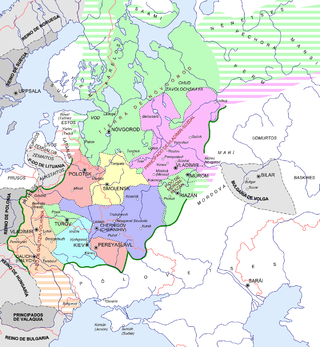
The inner Principality of Kiev was a medieval East Slavic state, situated in central regions of modern Ukraine around the city of Kiev.
The Battle of Listven (1024) was part of the aftermath of the Kievan succession crisis of 1015–1019 following the death of Vladimir the Great (Volodymyr) in 1015. It was fought between his sons Mstislav of Chernigov and Kievan forces supporting Yaroslav the Wise; Mstislav defeated Yaroslav. The battle is mainly known from the account written under the year 6532 (1024) in the Primary Chronicle, completed about 90 years later. According to that legendary narrative, the battle took place at night during a thunderstorm.

The Principality of Pereyaslavl was a regional principality of Kievan Rus' from the end of 9th century until 1323, based in the city of Pereyaslavl on the Trubizh River.

Yaropolk Iziaslavich was Prince of Turov and Prince of Volhynia from 1078 until his death.

The Principality of Peremyshl was a medieval petty principality centred on Peremyshl in the Cherven lands.
Mstislav II Svyatoslavich was a Kievan Rus' prince. His baptismal name was Panteleymon. He was probably prince of Kozelsk (1194–1223), of Novgorod-Seversk (1206–1219), and of Chernigov (1215/1220–1223). He was killed in the Battle of the Kalka River.
Yaroslav II Vsevolodovich was an Olgovichi prince. He was prince of Ropesk, of Starodub (1166–1176), and of Chernigov (1176–1198).
Yaropolk III Yaroslavich was a Kievan Rus' prince. He was prince of Novgorod (1197).

Sudislav Vladimirovich was Prince of Pskov from 1014 to 1036. He was imprisoned by his brother, Yaroslav the Wise, Grand Prince of Kiev, in about 1035. He was liberated from the prison in 1059 and died as a monk in a monastery in Kiev.
Roman Svyatoslavich or Roman the Handsome was prince of Tmutarakan in Kievan Rus'. The starting year of his reign is uncertain, but he reigned his principality from around 1073 or 1077. His former allies, the Cumans killed him after their unsuccessful joint campaign against his uncle, Vsevolod I of Kiev.

The sack of Kiev took place on 8–12 March 1169 when a coalition of 11 princes, assembled by prince Andrey Bogolyubsky of Vladimir-Suzdal, attacked the Kievan Rus' capital city of Kiev during the 1167–1169 Kievan succession crisis. The conflict, caused by the death of grand prince Rostislav I of Kiev, was between rival branches of the Monomakhovichi clan: the Iziaslavichi of Volhynia on the one hand, and the Rostislavichi of Smolensk, the Yurievichi, and the Olgovichi of Chernigov on the other. Prince Mstislav II of Kiev sought to defend Kiev against the Rostislavichi–Yurievichi–Olgovichi coalition.













